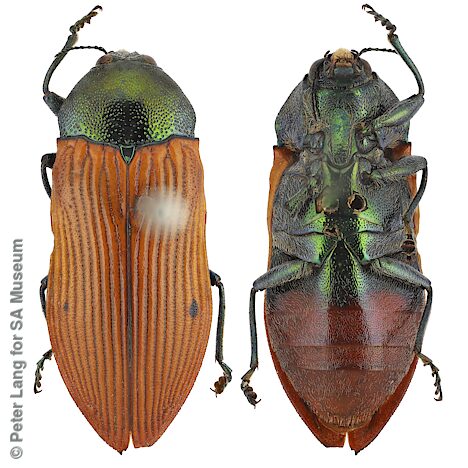
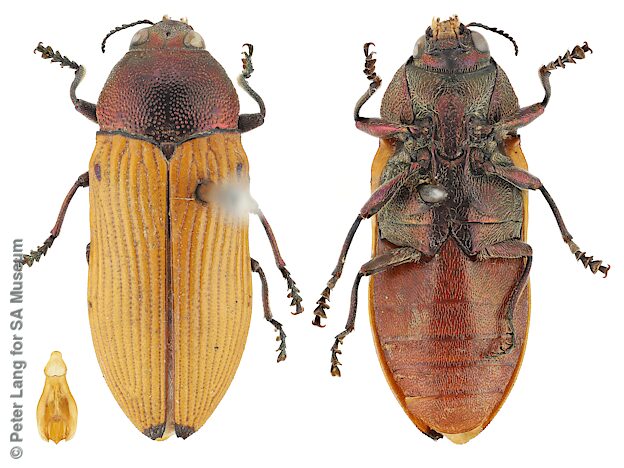
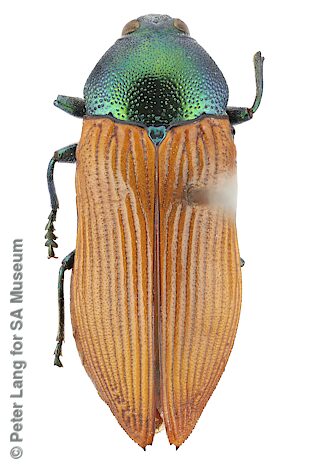
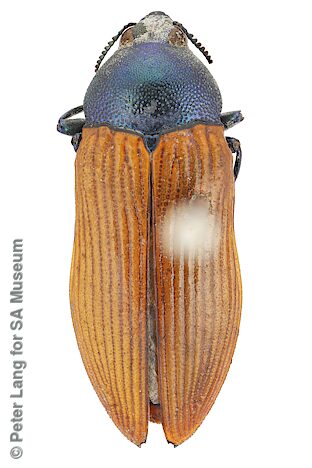
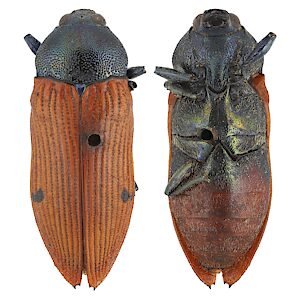
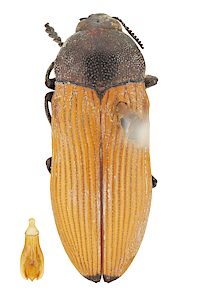
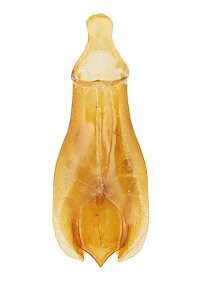
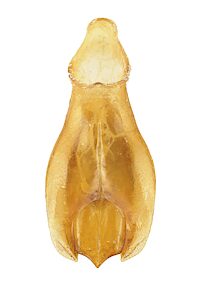
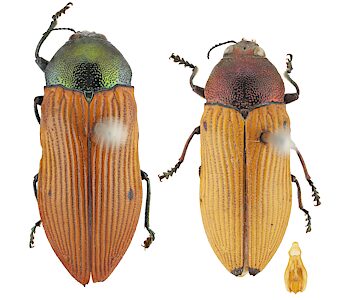
size¹:
×
5.9 mm









| male | female | |||||
|---|---|---|---|---|---|---|
| L1 | 14.7 | 14.65 – 14.7 | n = 2 | 16.0 | 15.3 – 16.9 | n = 4 |
| L2 | 14.3 | 14.3 – 14.3 | n = 2 | 15.6 | 15 – 16.65 | n = 4 |
| W | 5.6 | 5.45 – 5.7 | n = 2 | 6.1 | 5.6 – 6.8 | n = 4 |
| Legend | L1 | length from clypeus/frons to elytral apex (mean, range, sample size) |
| L2 | length from anterior of edge of eyes to elytral apex | |
| W | maximum width with elytra fully closed |
Similar to C. viridolinea and with straw-coloured elytra but differs in lacking a metallic green sutural strip and in being sexually dichromic with males coppery instead of green (or blue) on head, pronotum and ventral side. Also the females tend to be slightly broader in shape.
Castiarina guttata has the unfortunate distinction of being a jewel beetle species that is presumed extinct over all of its former range. It was probably endemic to SA, with the only definite locality records comng from the outer parts of the Southern Mt Lofty Ranges region (SL).
The holotype is an early collection from Lyndoch at the southern end of the Barossa Valley. In describing C. viridolinea which had been confused with this species, Barker 1986 commented that he was only aware of the early type specimens for C. guttata in the British Museum and drew attention to the lack of specimens in Australian collections. In his later treatment Barker 2006a cited several other old specimens from the SA Museum which correspond to those illustrated on this web page, viz. from Gawler, Reed Beds (now Fulham) and Black Swamp (probably near Currency Creek). He concluded that the species was possibly now extinct due to vegetation clearance.
The two SA Museum specimens labelled 'Australia W. White' most likely come from SA, as the naturalist W. White resided at the Reed Beds and made two other collections of C. guttata which are labelled with that locality. A Victorian specimen is listed for the Australian Museum with a 1998 determination as C. guttata but lacking a more specific locality and a date, and needs investigation.
Two male specimens that I collected from central Eyre Peninsula and identified as C. viridolinea (q.v.) approach C. guttata in having the head and pronotum pinkish-copper to bronze rather than green, but retain the sutural strip that is characteristic of C. viridolinea.
| Legend | P.J.Lang collection vouchered records | |
| other private collection or museum specimens, or sightings |
|
|
|
|
|
|
|
|
|
|
|
|
|
||||||||||||||||||||||||||||||||||||||||||||||||
|
|
|
|
|
|
|
|
|
|
|
|
|
||||||||||||||||||||||||||||||||||||||||||||||||
| Jul | Aug | Sep | Oct | Nov | Dec | Jan | Feb | Mar | Apr | May | Jun |
| Legend | ||
9 | number of active beetles, actually recorded in that quarter-month | |
| actual count > 2 (median) | ||
| actual count <= 2 (median) | ||
| ¹ Legend | regions | SA State Herbarium regions (map) EA: Eastern, EP: Eyre Peninsula, FR: Flinders Ranges, GT: Gairdner-Torrens, KI: Kangaroo Island, LE: Lake Eyre, MU: Murray, NL: Northern Lofty, NU: Nullarbor, NW: North-Western, SE: South-Eastern, SL: Southern Lofty, YP: Yorke Peninsula |
| size | The ellipse is the correct size when printed, indicative on a desktop screen, and likely to be wrong on a mobile device. |